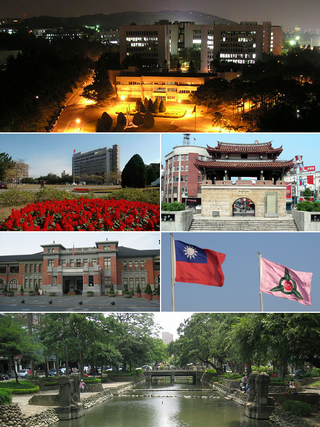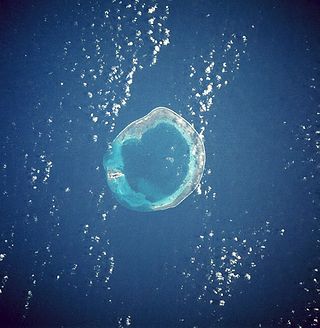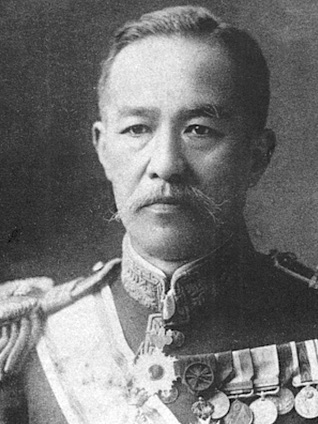| |||||
| Decades: | |||||
|---|---|---|---|---|---|
| See also: | Other events of 1930 History of Taiwan • Timeline • Years | ||||
Events from the year 1930 in Taiwan, Empire of Japan.
| |||||
| Decades: | |||||
|---|---|---|---|---|---|
| See also: | Other events of 1930 History of Taiwan • Timeline • Years | ||||
Events from the year 1930 in Taiwan, Empire of Japan.

Taiwan, officially the Republic of China (ROC), is a country in East Asia. It is located at the junction of the East and South China Seas in the northwestern Pacific Ocean, with the People's Republic of China (PRC) to the northwest, Japan to the northeast, and the Philippines to the south. The territories controlled by the ROC consist of 168 islands with a combined area of 36,193 square kilometres. The main island of Taiwan, also known as Formosa, has an area of 35,808 square kilometres, with mountain ranges dominating the eastern two-thirds and plains in the western third, where its highly urbanized population is concentrated. The capital, Taipei, forms along with New Taipei City and Keelung the largest metropolitan area in Taiwan. With around 23.9 million inhabitants, Taiwan is among the most densely populated countries.

The Republic of China Armed Forces, commonly known as the Taiwanese Armed Forces, are the armed forces of Taiwan. They consist of the Army, Navy, Air Force and Military Police Force. The military is under the civilian control of the Ministry of National Defense, a cabinet-level agency overseen by the Legislative Yuan.
The political status of Taiwan or the Taiwan issue is a long-running dispute on the status of Taiwan, currently controlled by the Republic of China (ROC). Originally based in Mainland China, the ROC government retreated to Taiwan in 1949 after the Chinese Communist Party (CCP) won the Chinese Civil War and established the People's Republic of China (PRC) in Mainland China. Since then, the effective jurisdiction of the ROC has since been limited to Taiwan, Penghu, Kinmen, Matsu, and smaller islands.

Hsinchu is a city located in northwestern Taiwan. It is the most populous city in Taiwan, not among the special municipalities, with estimated 450,655 inhabitants. Hsinchu is a coastal city bordering the Taiwan Strait to the west, Hsinchu County to the north and east, and Miaoli County to the south. Nicknamed the Windy City for its strong northeastern monsoon during the autumn and winter seasons.

The "National Anthem of the Republic of China", also known by its incipit "Three Principles of the People", is the national anthem of the Republic of China. It was adopted in 1930 as the national anthem and was used as such in mainland China until 1949, when the Republic of China central government relocated to Taiwan following its defeat by the Chinese Communist Party in the Chinese Civil War. It replaced the "Song to the Auspicious Cloud", which had been used as the Chinese national anthem before. The national anthem was adopted in Taiwan on October 25, 1945 after the surrender of Imperial Japan. Mainland China, being governed by the People's Republic of China today, discontinued this national anthem for "March of the Volunteers".
"Chinese Taipei" is the term used in various international organizations and tournaments for groups or delegations representing the Republic of China (ROC), a country commonly known as Taiwan.

Pratas Island, also known as the Tungsha Islands or the Dongsha Islands, is a coral island situated in the northern part of the South China Sea administered as part of Cijin District, Kaohsiung, Taiwan. It is located about 170 nautical miles southeast of Hong Kong. It has an area of about 240 hectares, including 64 hectares of lagoon, and is the largest of the South China Sea Islands. It is the location of the Dongsha Airport.

The Musha Incident (Chinese and Japanese: 霧社事件; pinyin: Wùshè Shìjiàn; Wade–Giles: Wu4-she4 Shih4-chien4; rōmaji: Musha Jiken; Pe̍h-ōe-jī: Bū-siā Sū-kiāⁿ), also known as the Wushe Rebellion and several other similar names, began in October 1930 and was the last major uprising against colonial Japanese forces in Japanese Taiwan. In response to long-term oppression by Japanese authorities, the Seediq indigenous group in the settlement of Musha (Wushe) attacked a Japanese village, killing over 130 Japanese. In response, the Japanese led a relentless counter-attack, killing over 600 Seediq in retaliation. The handling of the incident by the Japanese authorities was strongly criticised, leading to many changes in Aboriginal policy.

Hsieh Tung-min was the ninth Governor of Taiwan Province (1972–1978), the sixth and first local Taiwanese Vice President of the Republic of China (1978–1984) under president Chiang Ching-kuo.

Tsai Ing-wen is a Taiwanese politician who has been serving as the president of the Republic of China (Taiwan) since 2016. A member of the Democratic Progressive Party (DPP), Tsai is the first female president of Taiwan. She served as chair of the DPP from 2020 to 2022, and also previously from 2008 to 2012 and 2014 to 2018.

The Nationalist government, officially the National Government of the Republic of China, also known as the Second Republic of China or simply as the Republic of China, refers to the government of the Republic of China from 1 July 1925 to 20 May 1948, led by the Kuomintang.

The island of Taiwan, together with the Penghu Islands, became a dependency of Japan in 1895, when the Qing dynasty ceded Fujian-Taiwan Province in the Treaty of Shimonoseki after the Japanese victory in the First Sino-Japanese War. The short-lived Republic of Formosa resistance movement was suppressed by Japanese troops and quickly defeated in the Capitulation of Tainan, ending organized resistance to Japanese occupation and inaugurating five decades of Japanese rule over Taiwan. The entity, historically known in English as Formosa, had an administrative capital located in Taihoku (Taipei) led by the Governor-General of Taiwan.

Baron Den Kenjirō was a Japanese politician and cabinet minister in the pre-war government of the Empire of Japan. He was also the 8th Japanese Governor-General of Taiwan from October 1919 to September 1923, and the first civilian to hold that position. Den was also a co-founder of Kaishinsha Motorcar Works, a predecessor to present-day Nissan and the original manufacturer of Datsun automobiles.

Zhongshan Hall is a historic building which originally functioned as the Taipei (Taihoku) City Public Auditorium. It is located at 98 Yanping South Road in the Ximending neighborhood of Zhongzheng District, Taipei, Taiwan. In 1992, it was recognized by the government as a historic site.
Lo Tsung-lo was a Chinese botanist and plant physiologist. Lo was a main founder of modern plant physiology in China. He was the first President of National Taiwan University.

The status of women in Taiwan has been based on and affected by the traditional patriarchal views and social structure within Taiwanese society, which put women in a subordinate position to men, although the legal status of Taiwanese women has improved in recent years, particularly during the past two decades when the family law underwent several amendments.

The Republic of China (ROC), or simply China, was a sovereign state based in Mainland China from 1912 to 1949 prior to its move to Taiwan. It was first established on 1 January 1912, after being proclaimed in the 1911 Revolution against the Manchu-led Qing dynasty, and lasted until 7 December 1949, after its ruling party Kuomintang (KMT) was defeated by the Chinese Communist Party (CCP) at the de facto end of the Chinese Civil War, which resulted in a retreat of its central government to Taiwan, a territory which it took control of from the Empire of Japan in October 1945 after its surrender in World War II. The CCP-led People's Republic of China (PRC) then took over the governance of Mainland China with its capital in Beijing upon its establishment on 1 October 1949, while the ROC is now based on the island of Taiwan with its capital Taipei, where it retains actual rule over the Taiwan Area with the political status of Taiwan remaining in dispute to this day.

The Beipu Incident, or the Beipu Uprising, in 1907 was the first instance of an armed local uprising against the Japanese rule of the island of Taiwan. In response to oppression of the local population by the Japanese authorities, a group of insurgents from the Hakka subgroup of Han Chinese and Saisiyat indigenous group in Hoppo, Shinchiku Chō, attacked Japanese officials and their families. In retaliation, Japanese military and police killed more than 100 Hakka people. The local uprising was the first of its kind in Taiwan under Japanese rule, and led to others over the following years.
Events from the year 1964 in Taiwan, Republic of China. This year is numbered Minguo 53 according to the official Republic of China calendar.